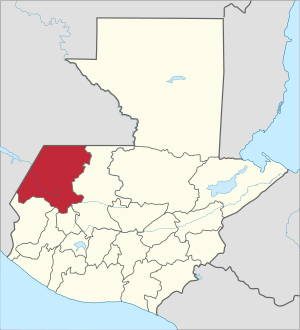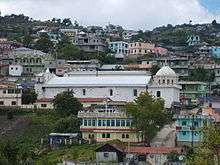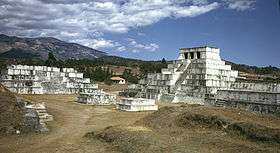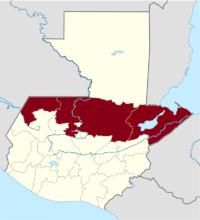Huehuetenango Department
Huehuetenango is one of the 22 departments of Guatemala. It is situated in the western highlands and shares borders with the Mexican state of Chiapas in the north and west; with El Quiché in the east, with Totonicapán, Quetzaltenango and San Marcos to the south. The capital is the city of Huehuetenango.[2]
Huehuetenango Department Departmento de Huehuetenango | |
|---|---|
 Flag  Coat of arms | |
 Huehuetenango | |
| Coordinates: 15°18′51″N 91°28′33″W | |
| Country | Guatemala |
| Capital | Huehuetenango |
| Municipalities | 31 |
| Government | |
| • Type | Departmental |
| Area | |
| • Department of Guatemala | 7,400 km2 (2,900 sq mi) |
| Highest elevation | 3,352 m (10,997 ft) |
| Lowest elevation | 300 m (1,000 ft) |
| Population (2018)[1] | |
| • Department of Guatemala | 1,170,669 |
| • Density | 160/km2 (410/sq mi) |
| • Urban | 327,297 |
| • Ethnicities | Mam, Q'anjob'al, Chuj, Jakaltek, Tektik, Awakatek, Chalchitek, Akatek, K'iche, Ladino |
| • Religions | Roman Catholicism, Evangelicalism, Maya |
| Time zone | UTC-6 |
| ISO 3166 code | GT-HU |
Huehuetenango's ethnic composition is one of the most diverse in Guatemala. While the Mam are predominant in the department, other Maya groups are the Q'anjob'al, Chuj, Jakaltek, Tektik, Awakatek, Chalchitek, Akatek and K'iche'. Each of these nine Maya ethnic groups speaks its own language.[3][4]
Name
The department of Huehuetenango takes its name from the city of the same name which serves as the departmental capital. The name is derived from the Nahuatl language of central Mexico, given by the indigenous allies of the Spanish conquistadors during the Spanish Conquest of Guatemala. It is usually said to mean "place of the elders" but may be a corruption of "place of the ahuehuete trees".[5]
Geography
Huehuetenango covers an area of 7,403 square kilometres (2,858 sq mi) in western Guatemala and is bordered on the north and west by Mexico. On the east side it is bordered by the department of El Quiché and on the south by the departments of Totonicapán, Quetzaltenango and San Marcos.[6] The department encompasses almost the entire length of the Sierra de los Cuchumatanes mountain range although there is a wide difference in altitude across the department, from heights of 3,352 metres (10,997 ft) above mean sea level to as low as 300 metres (980 ft) above sea level, encompassing an equally wide variation in local climate, ranging from mountain peaks where the temperature sometimes falls below freezing to tropical lowland rainforest.[7]
The department possesses various rivers that flow into the Chixoy River, also known as the Río Negro, which flows into the system of rivers forming the drainage basin of the Usumacinta River, which empties into the Gulf of Mexico. The most important tributaries of the Chixoy in Huehuetenango are the Hondo and Xecunabaj rivers, which flow into the department from the neighbouring departments of El Quiché and Totonicapán.[8]
The Cuilco River enters the department from neighbouring San Marcos and crosses into the Mexican state of Chiapas, where it joins with the Grijalva River, which empties into the Gulf of Mexico. Its most important tributaries in Huehuetenango are the Apal, Chomá and Coxtón rivers.[8]
The Ixcán River has its source near Santa Cruz Barillas and flows northwards towards Mexico where it joins the Lacuntún River, a tributary of the Usumacinta.[9]
The Nentón River is formed in the municipality of San Sebastián Coatán by the joining of the rivers Nupxuptenam and Jajaniguán. It flows westwards across the border into Mexico where it empties into the Presa de la Angostura reservoir.[10]
The Selegua River has its source in the Sierra de los Cuchumatanes and flows northwards, crossing the border into Chiapas, where it joins the Cuilco River to form the Grijalva River, to flow onwards to the Gulf of Mexico. Its principal tributaries are the Pino, Sibilá, Ocubilá, Naranjo, Colorado, Torlón, Mapá and Chicol rivers.[11]
The largest body of standing water in the department is Laguna Yolnabaj, in the extreme north, close to the border with Mexico. Smaller lakes include Laguna Maxbal, Laguna Yolhuitz, and Laguna Seca, all in the northeast of the department.[2]
Population

In 2018 the department was recorded as having 1,170,669 inhabitants.[1] Over 70% of the population are calculated to be living in poverty, with 22% living in extreme poverty and being unable to meet basic necessities.[12] The majority of the population (variously estimated at 64–75%) belongs to indigenous Maya groups with the remainder being Spanish-speaking Ladinos. The Ladinos tend to be concentrated in towns and villages including Huehuetenango, Cuilco, Chiantla, Malacatancito, La Libertad, San Antonio Huista and La Democracia, which have a relatively low indigenous population. In the rest of the department, the Maya groups make up the majority of the population as much in the towns as the countryside.[13] Huehuetenango has the greatest number of Mam Maya in Guatemala, although there are also Mam speakers in the departments of Quetzaltenango and San Marcos, and in the Mexican state of Chiapas.[14]
In 2008, 58% of the population of the department was aged 19 years or under.[15]
History
Early history

The area was occupied by the Maya civilization since at least the Mesoamerican Early Classic Period.[16] At the time of the Spanish Conquest, the Maya city of Zaculeu was the initial focus of Spanish attention in the region that would later become the department of Huehuetenango. The city was defended by the Mam king Kayb'il B'alam; it was attacked by Gonzalo de Alvarado y Chávez, cousin of Conquistador Pedro de Alvarado, in 1525.[17] After a siege lasting several months the Mam were reduced to starvation and Kayb'il B'alam finally surrendered the city to the Spanish.[18]
Four years after the Spanish conquest of Huehuetenango, in 1529, San Mateo Ixtatán, Santa Eulalia and Jacaltenango were given in encomienda to the conquistador Gonzalo de Ovalle, a companion of Pedro de Alvarado.[19] In 1684, a council led by Enrique Enriquez de Guzmán, the then governor of Guatemala, decided upon the reduction of San Mateo Ixtatán and nearby Santa Eulalia, both within the colonial administrative district of the Corregimiento of Huehuetenango.[20]
On 2 February 1838, Huehuetenango joined together with Quetzaltenango, El Quiché, Retalhuleu, San Marcos and Totonicapán to form the short-lived Central American state of Los Altos. The state was crushed in 1840 by general Rafael Carrera Turcios, at that time between periods in office as Guatemalan president.[21]
Huehuetenango includes pre-Columbian Maya archaeological sites at Zaculeu, Chalchitán, Mojá and San Mateo Ixtatán.[22]
Departmental history
The department of Huehuetenango was created by the presidential decree of Vicente Cerna Sandoval on 8 May 1866, although various attempts had been made to declare the district a department from 1826 onwards in order to better administer it.[23]
By 1883, Huehuetenango had 248 coffee plantations and produced 7334 quintals (Imperial hundredweight) of coffee.[24]
In 1887, a rebellion in Huehuetenango was put down by president Manuel Lisandro Barillas, who then suspended the constitutional guarantees of the department and rewrote its constitution.[25]
Economy and agriculture
During the 17th and 18th centuries, during the Spanish Colonial period, the main industries were mining and livestock production, run by Spaniards. In modern times agriculture is the most important industry, although mining continues on a small scale and handicraft production also contributes to the local economy.[26] Maize is cultivated across the whole department, without being limited by local climatic differences. The primary highland crops are wheat, potatoes, barley, alfalfa and beans. On the warmer lower slopes the primary crops are coffee, sugarcane, tobacco, chile, yuca, achiote and a wide range of fruits.[27]
Although historically cattle and horse farming was important, the size of production is much reduced in modern times, with the rearing of sheep now more widespread. Mines in Huehuetenango produce silver, lead, zinc and copper. Gold was once mined in the department but it is no longer extracted.[26] In 2000, the private mining company Minas de Guatemala S.A. was extracting antimony from underground mines near San Ildefonso Ixtahuacán.[28]
Local handicraft production mainly consists of weaving traditional Maya textiles, mostly cotton but also wool, depending on the local climate.[26]
In 2008 the most important product for exportation was coffee.[29]
Municipalities
The department of Huehuetenango includes 31 municipalities:[30]
| Municipality[30] | Ethnicity[30] | Population | Festival | Altitude | Extent |
|---|---|---|---|---|---|
| Aguacatán | Awakatek/Chalchitek | 45,506[31] | moveable[32] | 1,670 metres (5,480 ft)[32] | 300 square kilometres (120 sq mi)[32] |
| Chiantla | Ladino/Mam | 73,927[31] | 28 January–2 February[33] | 2,000 metres (6,600 ft)[33] | 536 square kilometres (207 sq mi)[31] |
| Colotenango | Mam | 25,091[34] | 15 August[31] | 1,590 metres (5,220 ft)[35] | 71 square kilometres (27 sq mi)[35] |
| Concepción Huista | Jakaltek | 18,378[34] | 6–8 December[36] | 2,220 metres (7,280 ft)[37] | 136 square kilometres (53 sq mi)[37] |
| Cuilco | Ladino | 46,407[38] | 25 November–1 December[39] | 1,150 metres (3,770 ft)[39] | 592 square kilometres (229 sq mi)[39] |
| Huehuetenango | Ladino | 102,294[31] | 16 July[31] | 1,901 metres (6,237 ft)[40] | 204 square kilometres (79 sq mi)[40] |
| Jacaltenango | Jakaltek | 41,112[34] | 2 February[41] | 1,438 metres (4,718 ft)[31] | 212 square kilometres (82 sq mi)[31] |
| La Democracia | Ladino | 48,430[42] | 2nd Friday of Lent[43] | 920 metres (3,020 ft)[42] | 136 square kilometres (53 sq mi)[42] |
| La Libertad | Ladino/Mam | 30,312[44] | 12–15 January[45] | 1,720 metres (5,640 ft)[45] | 104 square kilometres (40 sq mi)[45] |
| Malacatancito | Ladino/K'iche'[46] | 19,177[34] | 26 July[47] | 1,709 metres (5,607 ft)[47] | 68 square kilometres (26 sq mi)[47] |
| Nentón | Chuj | 38,820 | 15 January[48] | 780 metres (2,560 ft)[49] | 787 square kilometres (304 sq mi)[49] |
| San Antonio Huista | Ladino/Jakaltek | 13,756[50] | 8–12 December[50] | 1,230 metres (4,040 ft)[51] | 256 square kilometres (99 sq mi)[50] |
| San Gaspar Ixchil | Mam | 7,000[52] | 4–6 January[52] | 1,400 metres (4,600 ft)[52] | 34.9 square kilometres (13.5 sq mi)[52] |
| San Ildefonso Ixtahuacán | Mam | 30,466[53] | 20–25 January[53] | 1,580 metres (5,180 ft)[53] | 184 square kilometres (71 sq mi)[53] |
| San Juan Atitán | Mam | 14,860[34] | 25 June[54] | 2,440 metres (8,010 ft)[54] | 64 square kilometres (25 sq mi)[54] |
| San Juan Ixcoy | Q'anjob'al | 21,805[55] | 24 June[56] | 2,195 metres (7,201 ft)[56] | 224 square kilometres (86 sq mi)[55] |
| San Mateo Ixtatán | Chuj | 29,823[57] | 21 September[58] | 2,540 metres (8,330 ft)[59] | 560 square kilometres (220 sq mi)[59] |
| San Miguel Acatán | Akateko[4] | 24,329[34] | 29 September[60] | 1,780 metres (5,840 ft)[60] | 152 square kilometres (59 sq mi)[60] |
| San Pedro Necta | Mam | 31,112[34] | 5th Friday of Lent[61] | 1,520 metres (4,990 ft)[61] | 119 square kilometres (46 sq mi)[61] |
| San Pedro Soloma | Q'anjob'al | 37,499[62] | 28 June[63] | 2,270 metres (7,450 ft)[63] | 140 square kilometres (54 sq mi)[63] |
| San Rafael La Independencia | Akateko[64] | 11,638[34] | 24 October[65] | 2,377 metres (7,799 ft)[65] | 64 square kilometres (25 sq mi)[65] |
| San Rafael Petzal | Mam | 11,638[34] | 24 October[66] | 1,739 metres (5,705 ft)[66] | 38 square kilometres (15 sq mi)[66] |
| San Sebastián Coatán | Chuj | 22,316[34] | 20 January[67] | 2,350 metres (7,710 ft)[67] | 108 square kilometres (42 sq mi)[67] |
| San Sebastián Huehuetenango | Mam | 26,397[34] | 20 January[68] | 1,715 metres (5,627 ft)[68] | 108 square kilometres (42 sq mi)[68] |
| Santa Ana Huista | Jakaltek | 8,583 | 26 July[69] | 740 metres (2,430 ft)[69] | 145 square kilometres (56 sq mi)[69] |
| Santa Bárbara | Mam | 16,665[34] | 4 December[31] | 2,430 metres (7,970 ft)[70] | 448 square kilometres (173 sq mi)[70] |
| Santa Cruz Barillas | Q'anjob'al | 61,139[71] | 3 May[72] | 1,450 metres (4,760 ft)[72] | 1,112 square kilometres (429 sq mi)[31] |
| Santa Eulalia | Q'anjob'al | 36,175[73] | 12 February[73] | 2,580 metres (8,460 ft)[74] | 292 square kilometres (113 sq mi)[74] |
| Santiago Chimaltenango | Mam | 6,769[34] | 25 July[75] | 2,260 metres (7,410 ft)[75] | 39 square kilometres (15 sq mi)[76] |
| Tectitán | Mam | 9,436[77] | 22 July[78] | 2,210 metres (7,250 ft)[78] | 68 square kilometres (26 sq mi)[78] |
| Todos Santos Cuchumatán | Mam | 32,048[34] | 1 November[31] | 2,470 metres (8,100 ft)[31] | 300 square kilometres (120 sq mi)[79] |
People of note
Former president of Guatemala Efraín Ríos Montt was born in Huehuetenango city on 16 June 1926.[80]
Tourism

The main tourist attractions in the department include the source of the San Juan River and the restored Maya ruins of Zaculeu.[81] The town of Chiantla is a centre for religious tourism, with the Catholic Church being a pilgrimage destination due to its image of the Virgin of Candelaria, known locally as Nuestra Señora de Chiantla ("Our Lady of Chiantla").[82]
Notes
- Citypopulation.de Population of departments in Guatemala
- ITMB 2005.
- "Departamentos de Guatemala - Huehuetenango". Servicio de Información Municipal (SIM). Retrieved 2008. Check date values in:
|accessdate=(help). Rouanet et al 1992, pp.4-5. Rodríguez L., p.v. Díaz Camposeco et al 2008, pp.17, 19. - Akateko at Ethnologue
- Rouanet et al 1992, p.2.
- Rouanet et al 1992, p.1.
- Rouanet et al 1992, pp.5-6.
- Rouanet et al 1992, p.6. ITMB 2005.
- Rouanet et al 1992, p.7. ITMB 2005.
- Rouanet et al 1992, pp.6-7. ITMB 2005. GeoCenter.
- Rouanet et al 1992, pp.6-7. ITMB 2005.
- Díaz Camposeco et al 2008, p.13.
- Rouanet et al 1992, p.3. Hernández & González 2004.
- Rouanet et al 1992, p.4. Quintana Hernández & Rosales 2006, p.5.
- Díaz Camposeco et al 2008, p.14.
- Arroyo 2001, p.42.
- Polo Sifontes, undated.
- Recinos 1986, p.110.
- San Mateo Ixtatán at Inforpressca Archived 2011-06-07 at the Wayback Machine. (in Spanish) MINEDUC 2001, pp.14-15.
- Pons Sáez 1997, pp.149-150.
- Gaitán 2004?, pp.37-38.
- Rouanet et al 1992, pp.5, 7, 15. MINEDUC 2001, p.12.
- Rouanet et al 1992, pp.2-3.
- Wagner 2001, p.108.
- Gaitán 2004?, p.62.
- Rouanet et al 1992, p.8.
- Rouanet et al 1992, pp.8-10.
- Velasco pp.6.3, Table 2.
- Díaz Camposeco 2008, p.49.
- Rouanet et al 1992, pp.1-5.
- Hernández & González 2004.
- 40 days after Holy Week.Aguacatán at Inforpessca. Access date 2010-02-07. (in Spanish)
- Chiantla at Inforpessca. Archived 2005-04-03 at the Wayback Machine Access date 2010-02-07. (in Spanish)
- Estimated figure. Díaz Camposeco et al 2008, p.16.
- Colotenango at Inforpessca. Access date 2010-02-07. (in Spanish)
- Municipalidad de Concepción Husta Access date 2010-02-07. (in Spanish)
- Municipalidad de Concepción Husta Access date 2010-02-07. (in Spanish)
- Cuilco at Inforpessca. Access date 2010-02-07. (in Spanish)
- Cuilca at Inforpessca. Access date 2010-02-07. (in Spanish)
- Municipalidad de Huehutenango Access date 2010-02-07. (in Spanish)
- Municipalidad de Jacaltenango. Access date 2010-02-07. (in Spanish)
- La Democracia at Inforpessca. Access date 2010-02-07. (in Spanish)
- La Democracia at Inforpessca. Access date 2010-02-07. (in Spanish)
- La Libertad at Inforpessca. Access date 2010-02-07. (in Spanish)
- La Libertad at Inforpessca. Access date 2010-02-07. (in Spanish)
- Tarax Herrera et al 2005.
- Municipalidad de Malacatancito. Access date 2010-02-07. (in Spanish)
- Municipalidad de Nentón. Access date 2010-02-07. (in Spanish)
- Municipalidad de Nentón. Access date 2010-02-07. (in Spanish)
- San Antonio Huista at Inforpressca. Access date 2010-02-07. (in Spanish)
- Municipalidad de San Antonio Huista Access date 2010-02-07. (in Spanish)
- San Gaspar Ixchil at Inforpressca. Access date 2010-02-07. (in Spanish)
- San Ildefonso Ixtahuacán at Inforpressca. Access date 2010-02-07. (in Spanish)
- Municipalidad de San Juan Atitán Access date 2010-02-07. (in Spanish)
- San Juan Ixcoy at Inforpessca. Access date 2010-02-07. (in Spanish)
- Municipalidad de San Juan Ixcoy Access date 2010-02-07. (in Spanish)
- San Mateo Ixtatán at Inforpressca Access date 2010-02-07. (in Spanish)
- Municipalidad de San Mateo Ixtatán Access date 2010-02-07. (in Spanish)
- Municipalidad de San Mateo Ixtatán Access date 2010-02-07. (in Spanish)
- Municipalidad de San Miguel Acatán Access date 2010-02-07. (in Spanish)
- Municipalidad de San Pedro Nectar Access date 2010-02-07. (in Spanish)
- San Pedro Soloma at Inforpressca Access date 2010-02-07. (in Spanish)]
- Municipalidad de San Pedro Soloma Access date 2010-02-07. (in Spanish)]
- Languages of Guatemala and Belize at larutamayaonline.com. Access date 2011-07-17.
- Municipalidad de San Rafael La Independencia Access date 2010-02-07. (in Spanish)]
- Municipalidad de San Rafael Petzal Access date 2010-02-07. (in Spanish)]
- Municipalidad de San Sebastian Coatán Access date 2010-02-07. (in Spanish)
- Municipalidad de San Sebastian Huehuetenango Access date 2010-02-07. (in Spanish)
- Municipalidad de Santa Ana Huista Access date 2010-02-07. (in Spanish)
- Municipalidad de Santa Barara Access date 2010-02-07. (in Spanish)
- Santa Cruz Barillas at Inforpressca Access date 2010-02-07. (in Spanish)
- Municipalidad de Santa Cruz Barillas Access date 2010-02-07. (in Spanish)
- Santa Eulalia at Inforpressca Access date 2010-02-07. (in Spanish)
- Municipalidad de Santa Eulalia Access date 2010-02-07. (in Spanish)
- Municipalidad de Santiago Chimaltenango Access date 2010-02-07. (in Spanish)
- SEGEPLAN-USIGHUE 2002, p.7.
- Tectitán at Inforpressca Access date 2010-02-07. (in Spanish)
- Municipalidad de Tectitán Access date 2010-02-07. (in Spanish)
- Municipalidad de Todos Santos Cuchumatán Access date 2010-02-07. (in Spanish)
- Gaitán 2004?, p.149.
- Rouanet et al, pp.7, 17.
- Rouanet et al, pp.10-11.
References
- Arroyo, Bárbara (July–August 2001). "El Posclásico Tardío en los Altos de Guatemala". Arqueología Mexicana (in Spanish). Mexico: Editorial Raíces. IX (50): 38–43. ISSN 0188-8218. OCLC 29789840.
- Díaz Camposeco, Manrique; Megan Thomas; Wolfgang Krenmayr (2008). "Huehuetenango en Cifras" (PDF) (in Spanish). Huehuetenango, Guatemala.: Centro de Estudios y Documentación de la Frontera Occidental de Guatemala (CEDFOG). Archived from the original (PDF) on 2011-07-27. Retrieved 2010-02-09.
- Gaitán A., Héctor (c. 2004). Los Presidentes de Guatemala: Historia y Anécdotas (in Spanish). Guatemala City: Artemis & Edinter. ISBN 84-89452-25-3. OCLC 49591587.
- Hernández, Gonzalo; González, Miguel (2004). "Huehuetenango: Enclavado en la Sierra de los Cuchumatanes" (PDF) (in Spanish). Guatemala: Prensa Libre. Archived from the original (PDF) on 2011-07-15. Retrieved 2010-02-06.
- Guatemala (Map) (5th ed.). 1:470000. International Travel Maps. ITMB Publishing. 2005. ISBN 1-55341-230-3.
- MINEDUC (2001). Eleuterio Cahuec del Valle (ed.). Historia y Memorias de la Comunidad Étnica Chuj (PDF) (in Spanish). II (Versión escolar ed.). Guatemala: Universidad Rafael Landívar/UNICEF/FODIGUA. Archived from the original (PDF) on 2009-08-24. Retrieved 2010-02-06.
- Polo Sifontes, Francis. Zaculeu: Ciudadela Prehispánica Fortificada (in Spanish). Guatemala: IDAEH (Instituto de Antropología e Historia de Guatemala).
- Pons Sáez, Nuria (1997). La Conquista del Lacandón (in Spanish). Mexico: Universidad Nacional Autónoma de México. ISBN 968-36-6150-5. OCLC 40857165.
- Quintana Hernández, Francisca; Cecilio Luis Rosales (2006). Mames de Chiapas. Pueblos indígenas del México contemporáneo (in Spanish). Mexico: Comisión Nacional para el Desarrollo de los Pueblos Indígenas (CDI). ISBN 970-753-047-2. OCLC 254999882.
- Recinos, Adrian (1986). Pedro de Alvarado: Conquistador de México y Guatemala (in Spanish) (2nd ed.). Guatemala: CENALTEX Centro Nacional de Libros de Texto y Material Didáctico "José de Pineda Ibarra". OCLC 243309954.
- Rodríguez L., Carlos Antonio. "La Determinación Estadística de los Grupos Étnicos, el Indigenisma, la Situación de la Pobreza y la Exlusión Social. Los Censos Integrados del 2002 y la inclusión social de los grupos étnicos. Perfil nacional del desarrollo sociodemográfico" (PDF) (in Spanish). Retrieved 2010-02-07.
- Rodríguez Rouanet, Francisco; Fernando Seijas; Gerardo Townson Rincón (1992). Huehuetenango. Monografías de Guatemala, 2 (in Spanish). Guatemala: Banco Granai & Townson. OCLC 31405975.
- SEGEPLAN-USIGHUE (September 2002). "Caracterización del Municipio de Santiago Chimaltenango del Departamento de Huehuetenango" (PDF) (in Spanish). Huehuetenango, Guatemala: Secretaría Planificación y Programación/Unidad de Sistema de Información Geográfica de huehuetenango (SEGEPLAN-USIGHUE). Retrieved 2010-12-30.
- Tarax Herrera, Napoleón; Eulalio Argueta Calel; Víctor Manuel Larios Velásquez (September 2005). "Mitos, Cuentos y Leyendas Maya K'iche' en Malacatancito = Tzijonem B'anob'al Rech Kik'aslemal Ri K'iche'ab' Pa Ri Komon Malacatancito Ri K'o Nab'ajul" (PDF). Huehuetenango, Guatemala: helvetas Guatemala/Centro de Estudios y Documentación de la Frontera Occidental de Guatemala (CEDFOG). Archived from the original (PDF) on 2010-02-15. Retrieved 2010-02-08. (in Spanish and K'iche')
- Velasco, Pablo. "The Mineral Industries of Central America — Belize, Costa Rica, El Salvador, Guatemala, Honduras, Nicaragua, and Panama" (PDF). U.S. Dept. of the Interior, Bureau of Mines. OCLC 21384999. Retrieved 2010-02-09.
- Wagner, Regina (2001). Historia del Café de Guatemala (in Spanish). Bogotá, Colombia: Benjamín Villegas & Asociados. ISBN 958-96982-8-X. OCLC 50391255.
External links
- Información y Noticias de Huehuetenango. (in Spanish)
- Interactive department map (in Spanish)
- Estrategia de reducción de la pobreza - Huehuetenango (in Spanish)
- Huehuetenango General Information
